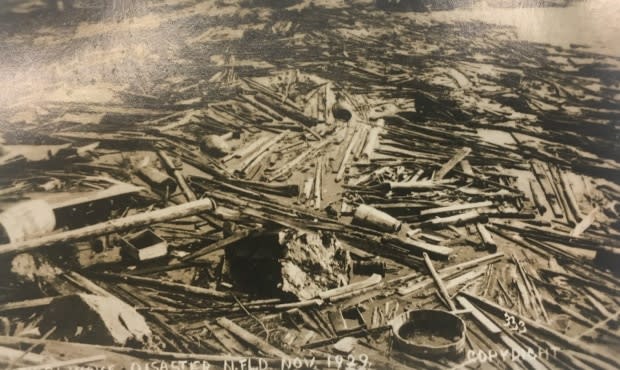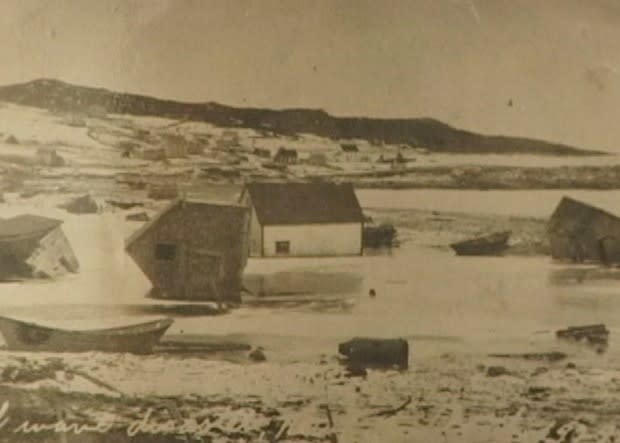90 years later, a tsunami in southern Newfoundland still brings vivid memories

The evening of Nov. 18, 1929 was like any other for five-year-old Gus Etchegary.
He sat in his kitchen as his two older sisters made dinner. His older brothers were in school; his dad, a St. Lawrence fisherman, was working.
"On the stove my sisters had potatoes on the top of a kettle keeping warm and suddenly — very suddenly — the plate began to shiver and shake very hard," Etchegary recalls.
The community had no way to know that it was about to be struck by a massive tsunami that would leave 28 people dead and hundreds homeless on Newfoundland's Burin Peninsula.
Etchegary said what he remembers is the immediate reaction his sisters had — one of terror.
"My two sisters panicked immediately and grabbed me by the two arms and … they were scared and in a panic, and they started to run toward the village with me right between them, hanging on," Etchegary said with a laugh at the memory of being hauled bodily through the town.

"And suddenly we came over the crest of the hill and we saw a whole gang of people coming up toward us, and of course these were people who lived around the harbour of St. Lawrence."
Etchegary and his family lived up a hill at a higher elevation, so when people felt the tremor of what would later prove to be a 7.2-magnitude earthquake under the Atlantic Ocean, they rushed away from the shoreline.
"An event like this caused great panic throughout the town," he said.
It wasn't until a couple hours later that the effects of the quake on the water wreaked havoc on the area.
'This was a major event'
In St. Lawrence, Etchegary said the moon was bright in the sky, and people could watch as the water came in — and went back out — and the destruction it left behind.
"The wave came in and it went back out, and as it receded out, the harbour practically dried out and the bottom of the ocean appeared inside the harbour, and then shortly after there was another huge wave, the second one, was even bigger and it continued to destroy the premises of the fishermen," he said.
"That receded and still a third came and it really demolished most of the fishing equipment, which of course included the boats and the stages and the stores that the fishermen had."
While he was just five at the time, Etchegary said he has "vivid" memories of a massive natural disaster.
"This was a major event that no one ever anticipated or understood … There was no precedent for an earthquake or a tsunami with all the destruction. No one ever realized that would ever happen," he said.
"It was something that stayed in my mind for quite a long time. It's 90 years ago."

The tsunami's effect was immediately felt in St. Lawrence, he said, as "completely demolished" equipment needed for the community's sole income lay in shambles.
"There were no roads between St. John's and the Burin Peninsula and there was no communications in those days — no radio, no telephone — to these areas, and so it was maybe two days before the government became fully aware of what had happened and the extent of the damage done," Etchegary said.
The 1929 tsunami has even inspired a new novel from Linden McIntyre, titled The Wake.
'It took everything from the shoreline'
Gordon Wagg was also five when the tsunami struck.
"I think I was laying on the floor when the tremors struck … and it was just a panicked thing," he said, recalling the reaction from the adults around him.

"Some thought the world was coming to an end, I think."
Wagg remembers going down to the wharf after the tsunami did its damage to realize all the fishing stages that were once there were gone — as were some homes built closer to the coastline.
"I didn't realize, with the wave coming in, what was going on. It took everything around the shoreline," he said.
Another nearby home came off its foundation. It was roped down to help people escape.
"There was enough water to come in and float that up. It was ridiculous, you know?"
Another family was not so lucky. Wagg remembers a mother and daughter who lived inside a home that was swept out to sea — with the two still inside.
They were never seen again, he said.
Earthquake caused underwater landslide

The tsunami is a huge event in Newfoundland and Labrador's history, and it's also an intriguing topic of study for geologists.
Calvin Campbell, a marine geologist with the Geological Survey of Canada, said the event is well studied, and provides some insight into underwater earthquakes.
The 1929 earthquake took place about 250 kilometres south of the Burin Peninsula in an area called the continental slope, which is off the edge of the continental shelf leading into deep ocean.
"The earthquake itself, the epicentre, was about 20 kilometres below the seabed, so quite deep, but that earthquake triggered a submarine landslide that flowed down the slope," he said.

"It was the movement of this massive sediment — or mud — down the slope that created the vertical displacement in the water the created the tsunami."
Over the years, scientists have studied the event and the sea floor in that area to assess the likelihood that it could happen again — or if it had happened previously.
During surveys in 2012 and 2016, Campbell said the seabed was mapped using sound. Through that method, they were able to get very high resolution images of the sea floor.
They found evidence of a "very large" submarine landslide about 200 kilometres south of 1929 area.
"When we did sampling on that site we realized that landslide happened about 1,500 years ago. So geologically speaking, relatively recent, and it was a very, very large landslide as well — it covered an area about three times the size of Prince Edward Island," he said.
From 2014, a CBC archival video on the 1929 tsunami:
Campbell added that "it would be almost impossible" to predict another one of these events in the future.
"Not every earthquake causes a tsunami, not every earthquake causes a landslide that might lead to a tsunami. … We certainly know that four of these types of events happened in the last 4,000 years," Campbell said.
"I think the important point here is to remind people that these type of events have happened in the past and they should be on people's minds for the future in terms of planning out the seabed and the coastal areas."
Read more articles from CBC Newfoundland and Labrador


